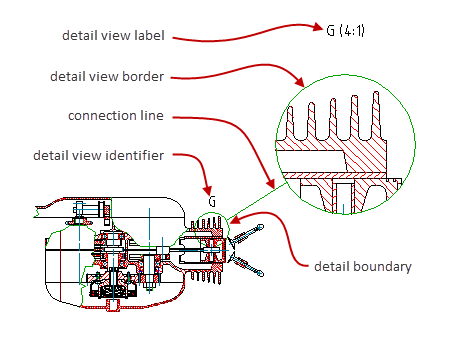Detail views allow you to select any portion of a drawing, enlarge it to a specified scale, and place it elsewhere in the drawing area. They give you the ability to annotate areas that cannot be displayed or dimensioned clearly.

A detail view is a convenient way to enlarge and annotate areas that can not be displayed or dimensioned clearly in the drawing. Power dimensions automatically recognize the scale factor of the detail view and displays the correct dimension values. Detail views ignore inappropriate objects, even if the area selected for detailing contains them. For example, if the area selected for enlarging contains annotations, detail views ignore them.
If mechanical structure is enabled, you get the option of creating detail views as mechanical structure entities. These are referred to as Associative Details, and are shown in the mechanical browser. Changes you make to the model automatically appear in the detail. Changes in the detail also appear in the model.
If mechanical structure is not enabled, or if you choose not to create associative details, changes you make to the model do not appear in the detail, automatically. You must explicitly double-click the detail boundary for the detail view to update.
You can create a detail view of a specified area in model space, in a layout, or in both. In layout, the detail can be represented as a zoomed viewport with a predefined scale. The advantage is that the representation of the detail and the model have the same elements. Hence, changes you make to the model appear in the detail automatically, regardless of whether mechanical structure is turned on or off.
You can grip edit the border enclosing the area selected for detailing to redefine area to detail. However, this action causes the detail view to be invalid. In such a case double-click the border enclosing the area selected for detailing and place the resulting new detail view in the drawing area. The detail view that existed prior to the update is deleted and the annotations it contained (if any) become disassociated.
The appearance of detail views are controlled by detail view styles.